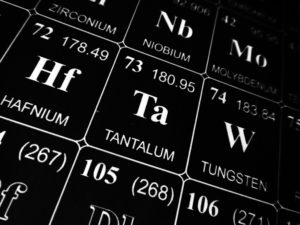
For their senior design projects, engineering students at the University of St. Thomas analyze the ethical factors in accordance with the ABET criteria for student outcomes. These include “an ability to apply engineering design to produce solutions that meet specified needs with consideration of public health, safety, and welfare, as well as global, cultural, social, environmental, and economic factors.” For most projects the economic- and environmental factors are straightforward. Engineering is all about using resources wisely. But when it comes to global factors, students are often at a loss. This is where the Responsible Minerals Initiative comes in. It helps companies track their supply chains for conflict minerals. It also helps students see how their projects affect stakeholders—not just the clients and their customers.
Responsible sourcing
The Responsible Minerals Initiative is part of responsible sourcing, which is the human-rights aspect of supply chains. The idea is that it’s not enough to follow ethical practices within your own business. It’s also important to pay attention to your supply chain to make sure that the raw materials and component parts you use are not products of exploited labor, unsafe working conditions, environmental destruction, or other unethical practices.
[R]esponsible suppliers are costly but adhere to strict social and environmental responsibility standards, whereas risky suppliers are less expensive but may experience responsibility violations. A segment of the consumer population, called socially conscious, is willing to pay a higher price for a product sourced from a responsible supplier and may not purchase in the event of a responsibility violation from a risky supplier.—Guo, Lee, and Swinney, Stanford Business School
Even small companies can practice responsible sourcing if they want to.
Conflict minerals
Section 1502 of the Dodd Frank Act of 2010 designates gold, tantalum, tin, and tungsten as “conflict minerals.” This law requires companies listing on United States stock exchanges to check their supply chains for any of these minerals that originate in the Democratic Republic of Congo or neighboring countries. In conflict zones in these countries, warlords fight for control of mines as sources of revenue. The intent of Section 1502 is to stop fueling conflicts with this money. The law does not prohibit companies from obtaining metals from Congo, or even from conflict zones. However, the reporting requirement encourages them to obtain the resources from mines outside conflict zones.
Gold: Whether it’s in jewelry or electronics, gold’s high value makes it profitable to smuggle and exchange in small quantities. That makes it difficult to trace a supply chain. According to the Responsible Minerals Initiative, gold may have links to “corruption, money laundering, theft, smuggling, fraud, and tax evasion, as well as human rights abuses stemming from organized crime and terrorist financing.” In addition, refining gold involves toxic materials such as cyanide or chlorine gas. Some companies have traced their gold back to the North Korean government, which refines gold. That put them in violation of US sanctions against North Korea, so they had to find other suppliers.
Tantalum: Tantalum is used in capacitors and certain alloys commonly found in electronic-, automotive-, and aerospace products.
Tin: The main use for tin is in soldering, so it’s important in electronics and electronic components. The main sources for tin are in China and Indonesia, with some deposits in Central Africa.
Tungsten: Tungsten’s strength and high melting point make it broadly useful in the electronics-, automotive-, and aerospace industries. The main sources are in China, with some coming from Central Africa.
Other materials of concern
Cobalt: Lithium-ion batteries in electric cars, mobile phones, and laptops rely on cobalt. Cobalt helps keep rechargeable batteries from catching fire, as well as enabling them to store and transfer more energy. More than half the world’s cobalt comes from Congo. Congo’s history of conflict, government corruption, human rights violations, and poor environmental practices make it a dubious source for cobalt even though it’s not an official conflict mineral.
Mica: Mica is used in everything from cosmetics and paint to electronic and automotive products. It comes mainly from India and Madagascar. Mica extraction and processing may involve child labor, illegal operations, and poor health and safety conditions for workers.
Other materials: The automotive- and electronics industries use many other materials that may come from questionable sources. The Material Change Report covers 37 materials, identifying the environmental, social, and governance concerns that each one poses. For example, aluminum generates high CO2 emissions. It also comes from countries with weak rule of law where corruption is rife. On the other hand, natural rubber has a very strong association with child labor and forced labor as well as conflicts with indigenous peoples.
What should companies do?
Although it may seem best for companies to withdraw from engagement with dubious sources of materials, it isn’t necessarily so. For one thing, it may not be possible to find alternative sources or substitute alternative materials. And even if it is, people working in dangerous or exploitive conditions need alternative employment. It may be preferable for companies to remain, but to press for better working conditions, see that children go to school, or seek alternative suppliers in the same geographical area.
We provide companies with tools and resources to make sourcing decisions that improve regulatory compliance and support responsible sourcing of minerals from conflict-affected and high-risk areas.— Responsible Minerals Initiative
A good first step would be to join the Responsible Minerals Initiative. Member companies can make use of their training, reporting templates, and information so that they can better comply with both the letter and the spirit of Dodd Frank.
The Responsible Business Alliance is an industry group that promotes corporate social responsibility in supply chains. In addition to the Responsible Minerals Initiative, it also supports the Responsible Labor Initiative and the Responsible Factory Initiative.
